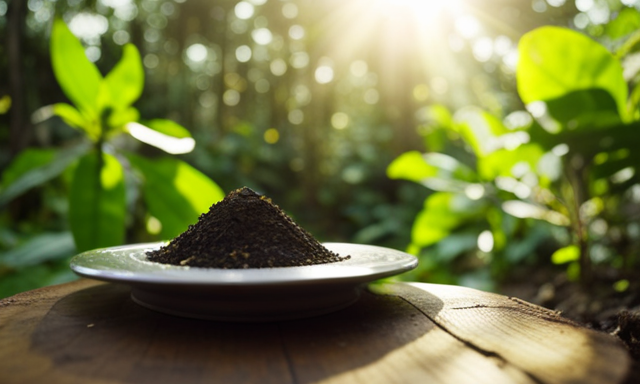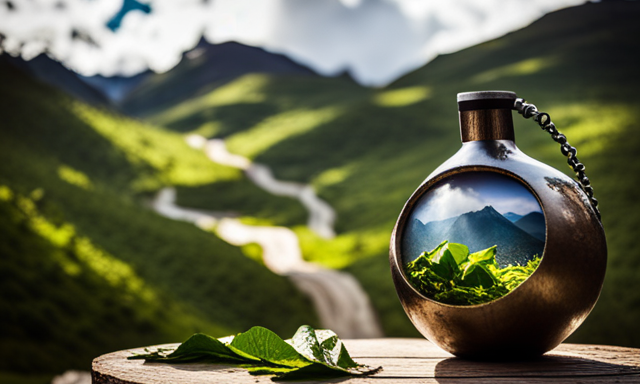As someone who has a deep appreciation for coffee, I constantly find myself searching for fresh sources of caffeine to fuel my day. Not too long ago, I discovered Yerba Mate, a classic beverage from South America that’s been increasing in popularity in the Western hemisphere.
If you’re like me and curious about this tea-like beverage, one question you might be asking is how much caffeine does it contain? Yerba Mate is often described as having a ‘smoky’ or ‘earthy’ taste and is traditionally consumed through a metal straw called a bombilla from a gourd-shaped container known as a mate.
But beyond its unique flavor and cultural significance, what makes Yerba Mate an attractive option for many people is its caffeine content. In this article, we’ll explore just how much caffeine Yerba Mate contains and compare it to other common sources of caffeine like coffee and tea.
Key Takeaways
- Yerba mate contains about 30-50mg of caffeine per cup (8 ounces), less than coffee but more than tea.
- Yerba mate offers a more balanced boost without unwanted side effects compared to coffee or energy drinks.
- Measuring caffeine intake is crucial to ensure the right amount of stimulation without overdoing it.
- Opting for traditional yerba mate preparation methods or purchasing from sustainable brands can reduce environmental footprint.
What is Yerba Mate?
Yerba mate is a traditional South American drink that’s made from dried leaves and twigs of the yerba mate plant. It has been consumed for centuries and played an essential role in many cultures, particularly in Argentina, Uruguay, Paraguay, and Brazil.
Yerba mate offers numerous health benefits as it contains antioxidants, vitamins, minerals, and amino acids. Consuming yerba mate can help increase energy levels, improve mental clarity and focus, boost immunity, aid digestion, and metabolism.
In addition to its health benefits, yerba mate also holds cultural significance. In South America, sharing a gourd of yerba mate with friends or family is a tradition that strengthens social bonds. Many people gather around the ‘mate circle,’ pass the gourd clockwise while sipping the tea through a metallic straw called ‘bombilla.’ This ritualistic process of sharing mates represents hospitality and friendship in South American culture.
Nowadays, yerba mate is consumed worldwide by millions of people who appreciate its unique taste and health benefits. Its popularity has grown over time due to its ability to provide caffeine without causing jitters or crashes like coffee does.
In the following section about ‘how is yerba mate consumed?’, we’ll explore different ways to prepare this energizing beverage that many people have incorporated into their daily lives.
How is Yerba Mate Consumed?
I’ve learned that Yerba Mate is a popular beverage in South America that contains caffeine. Now, I’m curious to know how it’s consumed.
From my research, I found out that there are two ways: traditional preparation and modern consumption.
Traditional preparation involves using a gourd and bombilla while modern consumption includes drinking it from a can or bottle.
Traditional Preparation
Just like a chef carefully prepares a meal, traditional yerba mate drinkers take great care in preparing their beverage to ensure the perfect balance of flavors and caffeine content. Traditional brewing involves packing yerba mate leaves into a gourd, adding hot water, and sipping through a metal straw called a bombilla. However, there’s an art to this process that goes beyond just boiling water and pouring it over tea leaves.
To prepare yerba mate in the traditional way requires patience, attention to detail, and respect for cultural significance. Here are some aspects of traditional preparation that make it so special:
-
The ritual: Preparing yerba mate is more than just making tea; it’s about connecting with friends and family while enjoying each other’s company.
-
The flavor: The taste of yerba mate varies depending on the type of leaves used, how they were dried or smoked, and the temperature of the water used to brew them.
-
The caffeine content: Yerba mate contains less caffeine than coffee but more than most teas. Drinkers often adjust the strength by altering how much herb is used per serving or adjusting brewing time.
-
The experience: Sharing yerba mate with others creates bonds between people as they pass around the gourd and share stories.
While traditional preparation may take longer than modern consumption methods like teabags or energy drinks, many appreciate its unique qualities. In contrast, modern habits tend to prioritize convenience over taste or ceremony.
Modern Consumption
Nowadays, people often opt for quicker and more convenient ways to consume yerba mate, such as using pre-made tea bags or energy drinks containing the herb. These modern consumption methods have made yerba mate more accessible in popular culture around the world. Companies like Guayaki and Taragui have capitalized on this trend by creating products that cater to the demand for quick and easy access to caffeine.
To give an idea of how much caffeine is in these products, I’ve created a table below comparing the amount of caffeine found in different forms of yerba mate:
| Type of Yerba Mate | Caffeine Content (mg) |
|---|---|
| Traditional Preparation (1 cup) | 30-50 |
| Pre-made Tea Bags (1 bag) | 30-35 |
| Energy Drinks (12 oz can) | 150 |
While the convenience of pre-made tea bags and energy drinks may be appealing, it’s important to consider their impact on sustainability. The production and distribution process for these products often leads to increased carbon emissions and waste. Therefore, if you’re someone who enjoys consuming yerba mate regularly, opting for traditional preparation methods or purchasing from sustainable brands can make a big difference in reducing your environmental footprint.
Understanding caffeine and its effects on our bodies is crucial when it comes to making informed decisions about our daily intake.
Understanding Caffeine
You might be surprised to learn that caffeine is a naturally occurring substance found in many plants, including yerba mate.
Caffeine metabolism can vary from person to person, but on average it takes about 4-6 hours for the body to metabolize half of the caffeine consumed. This means that if you consume a cup of yerba mate containing around 30-50mg of caffeine in the morning, you may still have some caffeine in your system later in the day.
To understand how caffeine affects our bodies, it’s important to know that it works by blocking adenosine receptors in our brain. Adenosine is responsible for making us feel tired and sleepy, so when we consume caffeine it helps us feel more alert and awake. However, too much caffeine can have negative effects on sleep quality and quantity.
It’s recommended that adults limit their daily intake to no more than 400mg of caffeine per day.
If you’re curious about how much caffeine is actually in yerba mate, there are a few factors to consider such as brewing time and method. On average, a cup of yerba mate contains around 30-50mg of caffeine. This is less than coffee but more than tea. However, because yerba mate also contains other natural compounds like theobromine and theophylline which can affect energy levels differently than just pure caffeine alone, some people report feeling more sustained energy without jitters or crashes after drinking yerba mate compared to other caffeinated beverages.
How Much Caffeine is in Yerba Mate?
When it comes to yerba mate, think of it as a gentle wave that provides sustained energy without the jitters or crashes often associated with other caffeinated beverages.
The caffeine content in yerba mate varies depending on the brand and how it is prepared. On average, one cup (8 ounces) of yerba mate contains about 30-50mg of caffeine, which is less than a cup of coffee but more than a cup of tea.
Despite its lower caffeine content compared to coffee, yerba mate has been shown to have a positive impact on energy levels due to its combination of caffeine and other compounds like theobromine and theophylline. These compounds work together to provide a smoother release of energy over time, rather than the sudden spike and crash that can occur with other sources of caffeine.
Comparing yerba mate to other caffeine sources reveals that its effects are unique due to its blend of natural compounds. In contrast to coffee or energy drinks, which can lead to jitters and anxiety in some people, yerba mate offers a more balanced boost without unwanted side effects.
Comparing Yerba Mate to Other Caffeine Sources
For a unique and balanced energy boost, nothing compares to the natural blend of compounds found in yerba mate when compared to other sources of caffeine.
When comparing caffeine content, yerba mate is generally lower than coffee but higher than tea. A typical serving of yerba mate contains around 30-50 mg of caffeine per cup while a cup of coffee can contain anywhere from 95-200 mg per cup.
Caffeine sources are not limited to traditional beverages like coffee and tea; energy drinks have become increasingly popular in recent years as a way to get a quick pick-me-up. However, these drinks often contain high levels of caffeine along with added sugars and other stimulants that can be harmful if consumed in excess.
When comparing yerba mate to energy drinks, it’s clear that the former provides a more natural source of energy without any added artificial ingredients.
While yerba mate may not have the highest levels of caffeine compared to other sources like coffee or energy drinks, its unique blend of compounds offers a more balanced and sustained level of energy throughout the day.
Understanding how different sources affect our bodies is important in making informed decisions about what we put into them.
Moving forward, let’s explore how exactly caffeine affects our bodies on both physical and mental levels.
How Does Caffeine Affect the Body?
As I sip on my favorite cup of yerba mate, I can feel the effects of caffeine surging through my body. Caffeine is a stimulant that affects the central nervous system and can cause changes in mood, energy levels, and alertness. It works by blocking adenosine receptors in the brain which leads to an increase in dopamine production.
As a result, caffeine is often referred to as addictive due to its ability to create physical dependence. While caffeine may provide temporary benefits such as increased concentration and productivity, it also has long term effects on our bodies. Studies have shown that excessive consumption can lead to negative health outcomes such as high blood pressure, irregular heartbeats, and even heart disease.
Additionally, those who consume large amounts of caffeine regularly may experience withdrawal symptoms when trying to quit. These symptoms can include headaches, irritability, fatigue, and difficulty concentrating. As much as we love the boost that caffeine gives us throughout our day-to-day lives, it’s important to be mindful of how much we consume and its potential consequences for our overall health.
In the next section about ‘caffeine sensitivity’, we’ll explore how some individuals are more susceptible to these effects than others based on their genetic makeup and lifestyle factors.
Caffeine Sensitivity
Are you someone who feels jittery and anxious after just a small cup of coffee? Well, it may be because you have a higher sensitivity to caffeine. Caffeine sensitivity varies from person to person, depending on factors such as age, weight, genetics, and overall health.
For some individuals, even the smallest amounts of caffeine can cause negative effects like heart palpitations or insomnia. If you’re highly sensitive to caffeine, it’s important to monitor your intake carefully. Consuming too much caffeine can lead to increased anxiety levels or even panic attacks.
On the other hand, low doses of caffeine can help improve focus and cognitive performance in some people. It’s all about finding the right balance for your body. Caffeine tolerance can also impact how sensitive an individual is to its effects.
Those who consume large amounts of caffeine regularly may develop a tolerance over time, meaning they need more caffeine to feel the same effects as before. However, if they suddenly stop consuming caffeine altogether, they may experience withdrawal symptoms such as headaches or fatigue. This is why it’s important to gradually reduce caffeine intake rather than quitting cold turkey.
To control your caffeine intake and minimize negative side effects related to sensitivity or tolerance issues, there are several strategies you can try. These include gradually reducing your daily intake over time instead of quitting abruptly; switching to decaf or non-caffeinated beverages; avoiding caffeinated products later in the day; and paying attention to how much caffeine is in each serving size by reading labels carefully.
By taking these steps towards moderation and awareness regarding our own individual sensitivities and tolerances towards this popular stimulant, we can optimize our wellbeing while still enjoying the benefits that this wonderful substance has been shown to help provide!
How to Control Caffeine Intake
When it comes to controlling my caffeine intake, I’ve found that choosing the right yerba mate products and measuring my intake are key.
Firstly, I make sure to select a product that clearly lists the amount of caffeine per serving. This helps me stay within my desired limit.
Additionally, I use a kitchen scale or measuring spoon to accurately measure out each serving so that I can keep track of how much caffeine I’m consuming throughout the day.
Choosing Yerba Mate Products
To pick the perfect yerba mate product, imagine yourself holding a warm gourd filled with rich and earthy loose-leaf tea. Yerba mate is a traditional South American drink that’s been enjoyed for centuries. Nowadays, it’s widely available in different forms such as tea bags, bottled drinks, or ready-to-drink cans.
When choosing yerba mate products, there are some factors to consider such as flavor and brand comparison. The flavor of yerba mate can vary depending on the processing method, origin, and aging process of the leaves. Some brands offer flavored options like mint or citrus while others stick to the classic natural taste. It’s worth trying out different brands and flavors to find your favorite one. Additionally, reading reviews and comparing prices can help you make an informed decision about which brand to go for.
Once you’ve found your ideal yerba mate product, it’s time to measure your caffeine intake. Without abruptly changing topics, let me tell you how important it is to know how many mg of caffeine are in yerba mate before consuming it regularly.
Measuring Caffeine Intake
You’ll be surprised to know that a typical serving of yerba mate contains about as much caffeine as a cup of coffee, making it a great alternative for those who want to cut down on their coffee consumption. However, it’s important to keep in mind that not all yerba mate products are created equal. Some may have higher levels of caffeine due to the way they are processed or blended with other ingredients. This is why measuring caffeine intake is crucial if you want to ensure you’re getting the right amount of stimulation without overdoing it.
To help you understand how much caffeine you’re consuming with each serving, I’ve created a table below that compares the levels found in different types of yerba mate products as well as other popular drinks. Keep in mind that your individual tolerance for caffeine will also play a role in how much is too much for you personally. It’s always best to start with smaller amounts and gradually increase your intake if needed while paying attention to how your body reacts.
Moving onto the next section about ‘yerba mate and health’, let’s explore some of the many benefits this drink has been associated with over centuries of use.
Yerba Mate and Health
Did you know that yerba mate contains several health benefits, such as antioxidants and vitamins, making it a great alternative to coffee for your daily caffeine intake? Yerba mate has been consumed in South America for centuries due to its cultural significance. This beverage is brewed from the leaves of the Ilex paraguariensis plant and is known for its stimulating properties.
One of the potential benefits of drinking yerba mate is its high antioxidant content. Antioxidants are compounds that protect our cells from damage caused by free radicals, which can contribute to various health problems. In fact, studies have found that yerba mate has higher antioxidant activity than green tea!
Additionally, yerba mate contains several vitamins and minerals such as vitamin C, vitamin B1 (thiamine), and magnesium.
Another benefit of consuming yerba mate is its potential ability to boost mental alertness and physical performance. The caffeine content in yerba mate is lower than coffee but still provides a stimulating effect. Some research suggests that this may be due to other compounds present in the drink such as theobromine and theophylline. These compounds may also have anti-inflammatory effects on the body.
Incorporating yerba mate into your daily routine can offer several potential health benefits beyond just providing a caffeine kick. From its high antioxidant content to its ability to improve mental focus and physical performance, this traditional South American drink has much more to offer than meets the eye!
Frequently Asked Questions
What is the history and cultural significance of Yerba Mate?
Yerba mate is a traditional South American drink that holds significant cultural importance in the region. It’s been used for centuries as a social and medicinal beverage. Its preparation and consumption are deeply ingrained in many communities’ daily routines.
The cultural significance of yerba mate is highlighted by its role as a symbol of friendship, hospitality, and tradition. Its traditional preparation involves steeping dried leaves from the yerba mate plant in hot water using a gourd (a hollowed-out fruit) and sipping through a metal straw called ‘bombilla.’ This process creates an experience that fosters connection and community among those who share it.
Yerba mate’s cultural significance is not limited to South America. It has gained popularity worldwide due to its unique flavor profile and health benefits.
Are there any negative side effects of consuming Yerba Mate?
Oh boy, where do I even begin with yerba mate. It’s been a staple in my daily routine for years now and I absolutely swear by it.
But, like most things in life, there are potential negative effects of consuming too much yerba mate. These can include anxiety, insomnia, and digestive issues.
That being said, as long as you stick to the recommended daily intake of about 3-4 cups (or 1 liter) per day and listen to your body’s reactions, you should be just fine.
As for the question of how many mg caffeine in yerba mate? Well, on average there is about 30-50mg per cup depending on the brand and preparation method. But let’s not get too caught up in numbers, shall we?
Let’s focus on enjoying our beloved yerba mate in moderation and with mindfulness towards our bodies’ individual needs.
Does the caffeine content in Yerba Mate vary depending on the brand or preparation method?
From my experience, I’ve found that the caffeine content in yerba mate can vary depending on the brand and preparation method. Brewing techniques such as steeping time and temperature can also impact caffeine levels. Some brands may use more mature leaves which contain higher levels of caffeine compared to those using younger leaves or stems.
In terms of caffeine comparisons, yerba mate typically has less caffeine than coffee but more than tea. However, it’s important to note that individual sensitivity to caffeine can vary greatly and it’s always best to listen to your body when consuming any type of caffeinated beverage.
Can Yerba Mate be used as a substitute for coffee or other caffeinated beverages?
Yerba mate can definitely be used as a substitute for coffee or other caffeinated beverages. I’ve found that it provides a more sustained and steady form of energy, without the jitters or crash that can come from coffee.
In terms of health benefits, yerba mate contains antioxidants and nutrients such as vitamins B and C, magnesium, and potassium. It’s also been shown to boost mental focus and improve physical endurance.
While the caffeine content in yerba mate may vary depending on the brand or preparation method, it generally contains about 30-50 mg per serving compared to coffee’s 95 mg per cup on average. However, it’s important to note that excessive consumption of any caffeinated beverage can lead to negative effects such as anxiety and insomnia.
Ultimately, incorporating yerba mate into your daily routine could provide a healthier alternative to traditional forms of caffeine while still providing a boost in energy and focus.
Is Yerba Mate safe for pregnant or breastfeeding women to consume?
As a pregnant or breastfeeding woman, I’ve wondered about the safety of consuming Yerba Mate. After researching the topic, I found that while Yerba Mate has many potential health benefits due to its high nutrition content, it also carries some risks.
The caffeine content in Yerba Mate can be concerning for pregnant and breastfeeding women as excessive intake of caffeine can lead to adverse effects on fetal growth and development. Additionally, Yerba Mate has been linked to an increased risk of certain cancers if consumed in large amounts.
However, when consumed in moderation, Yerba Mate may aid weight loss efforts due to its ability to increase metabolism and suppress appetite. Ultimately, it’s important for pregnant and breastfeeding women to consult with their healthcare provider before consuming Yerba Mate or any other caffeinated beverages regularly.
Conclusion
Well folks, it looks like yerba mate is a pretty good source of caffeine. As someone who enjoys a nice cup of mate every now and then, it’s reassuring to know that I’m getting a decent dose of caffeine along with all the other health benefits.
Of course, everyone’s sensitivity to caffeine is different, so it’s important to be mindful of how much you’re consuming.
Overall, yerba mate seems like a great alternative to coffee or energy drinks for those looking for an energy boost. And hey, even if you’re not in it for the caffeine, the taste and cultural significance make it worth trying at least once.
So go ahead and give yerba mate a shot – your body (and taste buds) will thank you!










